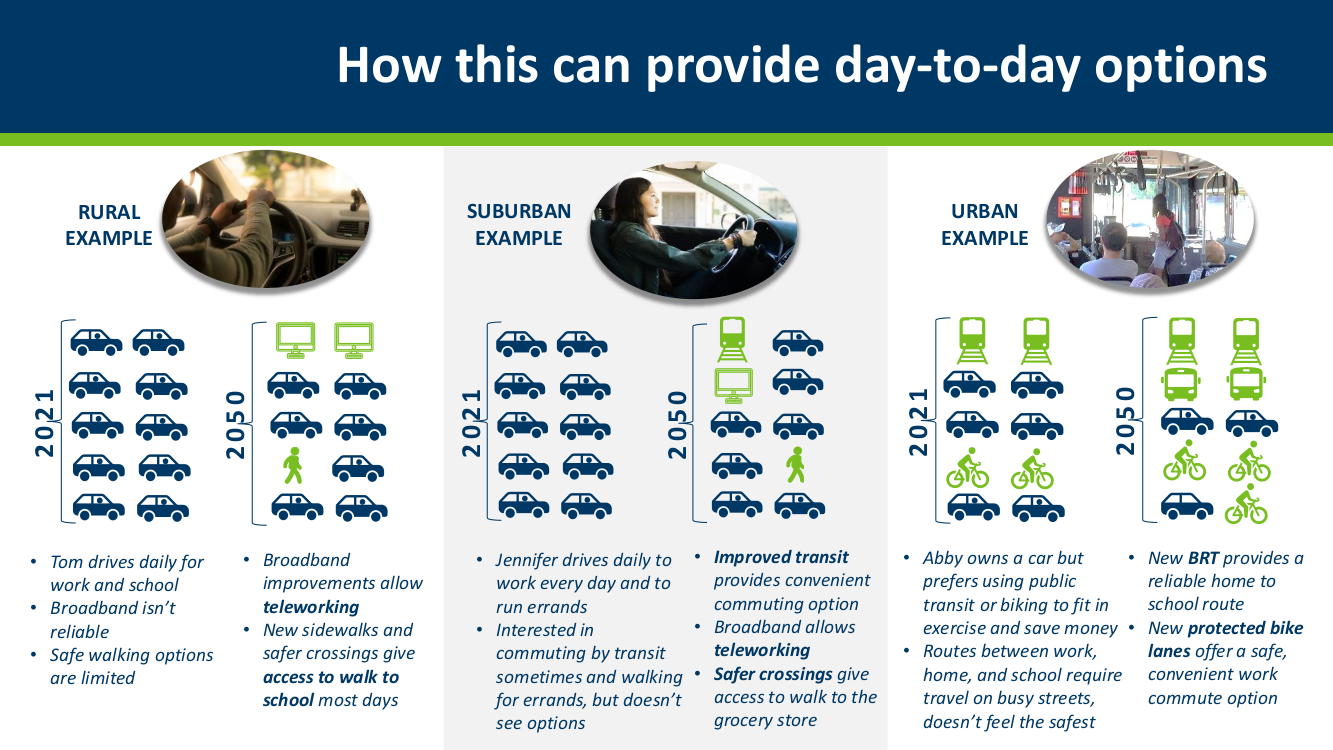
Analysis: Minnesotans Would Save up to $91 Billion from Climate-Smart Transportation
Investments in clean transportation would expand options while saving Minnesotans money and making communities safer and healthier.
New analysis from RMI shows that Minnesota would see up to $91 billion in benefits from climate-smart transportation investments. Specifically, that scale of benefits occurs if the state meets the Minnesota Department of Transportation’s (MnDOT) goal to expand transportation options and reduce driving (vehicle miles traveled) by 20 percent per capita by 2050. To put this into context, that’s an average annual benefit of $3.4 billion, which is larger than the state’s entire coal and natural gas market in 2022.
In addition to the direct health, safety, and vehicle operation cost savings for everyday Minnesotans, RMI finds that achieving MnDOT’s goal of carbon neutral surface transportation by 2050 would prevent an additional $81 billion of damage to industries ranging from agriculture to real estate. By advancing strategies to increase transit, biking, and walking networks in addition to vehicle electrification, Minnesota has a tremendous opportunity to accelerate its climate leadership and unlock benefits that create a cleaner, more equitable transportation system for all.
No silver bullet in transportation emission reductions
Direct tailpipe emissions from transportation are the largest source of greenhouse gases in Minnesota, accounting for 25 percent of the state’s climate pollution. While Minnesota has made progress in reducing emissions from the transportation sector and has passed clean car sales standards, more needs to be done to meet the agency’s goal of carbon neutrality by 2050. According to RMI analysis using the Energy Policy Simulator, even if all states copied California’s rule phasing out gas car sales by 2035, only about 27 percent of the fleet would be electrified within the next decade. In its 2019 “Pathways to Decarbonization” report, MnDOT found that there’s no “silver bullet,” and that the state will need a suite of policies beyond electrification to completely decarbonize the sector. Those tactics include increasing investments in public transportation, creating more charging infrastructure, and accounting for greenhouse gas emissions in transportation project construction and operation.
These policies align with previous RMI reporting that one of the most impactful ways to slash transportation emissions is to reduce the amount people have to drive, also referred to as vehicle miles traveled, or VMT. This means expanding quality transportation options so that people have more freedom to choose how they travel beyond single-occupancy car trips. As shown in Exhibit 1, this could look like increasing safe walking and biking access, expanding reliable transit options, and encouraging development that places more housing within close, convenient reach of essential services and amenities. This doesn’t mean people won’t have the option to drive; it means reducing over-reliance on cars by offering safer, more convenient alternatives that reduce pollution and increase quality of life.
Exhibit 1: MnDOT graphic showing the benefits of expanding transportation options
Since MnDOT’s report was released, the urgency of adopting its recommendations has never been greater. Landmark legislation like the Bipartisan Infrastructure Law (BIL) injected an additional $1.2 billion dollars into MnDOT’s budget. Analysis shows that if the money is primarily directed to expand highways, this funding could actually increase pollution and fail to alleviate traffic congestion. If MnDOT is serious about reaching its carbon-neutrality goals, this funding must also be rapidly invested in clean transportation projects, like transit, walking, and cycling. Prioritizing these projects would make Minnesota more likely to unlock additional, competitive funding from BIL for projects that prioritize environmental and equity outcomes. Just last year, MnDOT brought home an additional $43 million of funding by winning two competitive BIL grants — each awarded project featured an emphasis on adding walking and biking options to existing infrastructure.
Exhibit 2: MnDOT transportation goals versus business-as-usual projections
Minnesotans could see significant savings from expanding transportation options
RMI investigated what the benefits would be if Minnesota were to achieve its VMT reduction targets of 20 percent per capita by 2050. A detailed methodology of this analysis is available here. The analysis found that achieving MnDOT’s mode shift goal could result in significant savings for Minnesotans, including:
- Reduced operations costs: By 2030, each household can expect to save about $500 per year on vehicle operating costs from reduced trips to the pump for gas and to the mechanic for maintenance. By 2050, each household would cumulatively save $16,000 from access to more efficient transportation choices. At the state level, these benefits would add up to $35 billion dollars of total savings in the same time period. These figures exclude any benefits of families being able to reduce household vehicle ownership in response to improved access to alternative transportation options.
- Reduced crash injuries, fatalities, and costs: By 2030, Minnesota’s expansion of transportation choices would prevent 65 deaths and 1,000 injuries per year from avoided car crashes. This is because single occupancy vehicles are by far the most dangerous form of transportation, whereas transit deaths are rare. By 2050, achieving the VMT goal would prevent 2,800 deaths and 42,000 injuries in total, saving $54 billion in comprehensive costs for the state and taxpayers.
- Health benefits from active transportation: By 2030, achieving MnDOT’s mode shift goal would promote healthy, active transportation by shifting trips to biking and walking. The increased physical activity and reduced cardiovascular mortality would improve health outcomes and prevent up to 500 deaths per year by 2030, representing 20,000 total prevented deaths by 2050.
- Health benefits from improved air quality: By 2030, expanding transportation options would reduce air pollution and improve health outcomes. Even under an optimistic projection of electric vehicle adoption in Minnesota, RMI found that achieving MnDOT’s mode shift goal would unlock an additional benefit of $1 billion from avoided automobile pollution fatalities by 2050. These savings exclude the potential benefits from reducing non-exhaust pollution from automobiles.
Exhibit 3: Minnesota’s cost savings from climate-smart transportation
In total, these savings reach $5 billion annually by 2050 — for a cumulative $91 billion of direct cost savings for Minnesotans. With accelerated ambition, the Gopher State could unlock the $5 billion annual benefit decades earlier by aiming to achieve the 20 percent per-capita VMT reduction by 2030. This accelerated target would be in line with the recommendations of the state’s own Sustainability Transportation Advisory Council as well as previous RMI analysis of what is needed for a safe climate future.
Climate benefits from comprehensive transportation strategy
In addition to the above in-state benefits, our analysis considered the global impact of achieving MnDOT’s goal to eliminate the North Star State’s surface transportation emissions by 2050. Using the federal government’s most up-to-date social cost of carbon, a measure designed to evaluate the aggregate cost of carbon pollution to the world economy, the analysis found that Minnesota’s leadership in achieving carbon neutrality in surface transportation by 2050 would prevent over $82 billion in damages to industries ranging from agriculture to real estate. These savings also include averted fatalities and medical complications from climate-fueled natural disasters. Achieving the target early, by 2040, would increase the prevented damages by 32 percent to $111 billion of savings.
Exhibit 4: Achieving emissions targets early leads to greater savings.
Minnesota’s climate future: thousands of lives and tens of billions of savings are at stake
The land of 10,000 lakes has the opportunity to bring immense economic and health benefits — up to $91 billion worth — to its taxpayers by investing in cleaner, more equitable transportation solutions. This analysis finds that every Minnesotan stands to benefit from cleaner air, better health, and savings at the pump. The opportunity to act on climate change is narrowing — and both the local and global costs of failing to act are immense. Minnesota decision makers should consider codifying and accelerating MnDOT-recommended carbon-neutrality strategies, like goals to expand transportation options and incorporating climate change into project-level planning, to lock in the most equitable and cost-saving transportation system for its residents.
